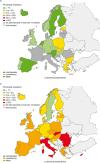Overview of ESBL-producing Enterobacteriaceae from a Nordic perspective
- PMID: 25317262
- PMCID: PMC4185132
- DOI: 10.3402/iee.v4.24555
Overview of ESBL-producing Enterobacteriaceae from a Nordic perspective
Abstract
Extended spectrum β-lactamases (ESBL) are increasing rapidly worldwide. E. coli producing CTX-M type ESBLs are the most common clinically encountered. The majority of E. coli ESBL infections are represented by urinary tract infections, but they can also cause severe infections, for example, in the blood stream and central nervous system. Since E. coli is a common colonizer of the normal gut microbiota, increasing prevalence of ESBL-producing strains is particularly worrisome. Once disseminated in the community, containment of this resistance type will be challenging. The driver of ESBL-producing Enterobacteriaceae (EPE) is debated. Some suggest that the ESBL genes were introduced to particularly successful bacterial clones. Others imply that very successful plasmids drive the rapid dissemination. More research and epidemiological studies of strain types, plasmids and mobile genetic elements are needed for these questions to be answered. In order to combat, or at least slow down, the worrisome trend of increasing numbers of EPE more knowledge is also needed on persistence of EPE in carriers as well as better understanding of how antibiotic treatment and other risk factors affect persistence and further dissemination. This review aims at giving an overview of this global problem from a Nordic perspective.
Keywords: E. coli; K. pneumoniae; antibiotic resistance; epidemiology; extended spectrum β-lactamase.
Figures



References
-
- Birkett CI, Ludlam HA, Woodford N, Brown DF, Brown NM, Roberts MT, et al. Real-time TaqMan PCR for rapid detection and typing of genes encoding CTX-M extended-spectrum beta-lactamases. J Med Microbiol. 2007;56:52–5. - PubMed
-
- D'Andrea MM, Arena F, Pallecchi L, Rossolini GM. CTX-M-type beta-lactamases: a successful story of antibiotic resistance. Int J Med Microbiol. 2013;303:305–17. - PubMed
Publication types
LinkOut - more resources
Full Text Sources
Other Literature Sources
